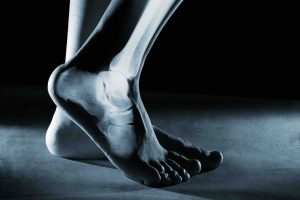Lateral Column Lengthening
What is the lateral column?
 The calcaneus, the cuboid, and the fourth and fifth metatarsals make up the lateral column. During a lateral column lengthening procedure, the surgeon aims to lengthen that area of the foot.
The calcaneus, the cuboid, and the fourth and fifth metatarsals make up the lateral column. During a lateral column lengthening procedure, the surgeon aims to lengthen that area of the foot.
What indicates the need for a lateral column lengthening?
Orthopedic foot and ankle surgeons may perform a lateral column lengthening if the patient suffers from a flat foot or foot that rotates outward. A lateral column lengthening, also called a calcaneal lengthening or Evans osteotomy, helps improve the positioning of the foot. Surgeons often pair a lateral column lengthening with other procedures like a medializing calcaneal osteotomy.
How do surgeons perform a lateral column lengthening?
During a lateral column lengthening, the foot and ankle surgeon makes a cut on the outside of the affected foot. The surgeon then cuts the outside of the heel bone and inserts a trapezoidal shaped bone graft into the lateral column. The graft can come from the patients’ hip (called an autograft) or come from a cadaver (called an allograft). The graft places pressure on the foot and brings the foot into a straighter position. Special hardware holds the graft and the bone together so they can grow together to form one bone. For a lateral column lengthening, orthopedic foot and ankle specialists may use pins, plates, screws, or other types of applicable hardware. The surgeon removes the chosen hardware after 3-4 weeks of healing.
Potential risks and complications following a lateral column lengthening
Due to the nature and complexity of lateral column lengthening surgery, risks and complications may arise. Potential complications following lateral column lengthening surgery include the following:
- Infection
- Poor wound healing
- Nerve damage
- Nonunion
- Over correction or under correction
- Hardware causing pain
Recovering from lateral column lengthening surgery
Following lateral column lengthening surgery, patients wear a cast and must use crutches to protect the surgical foot. When sleeping, the heel of the surgical foot should always remain off of the bed. The doctor prescribes the patient medication to manage the postoperative pain and schedules follow up visits. The foot and ankle surgeon also prescribes the patient a physical therapy protocol. All surgeons have different protocols so patients must follow the protocol of their specific provider.
To view a list of all insurances that AOA Orthopedic Specialists accept, click HERE. To schedule an appointment online, click HERE.


